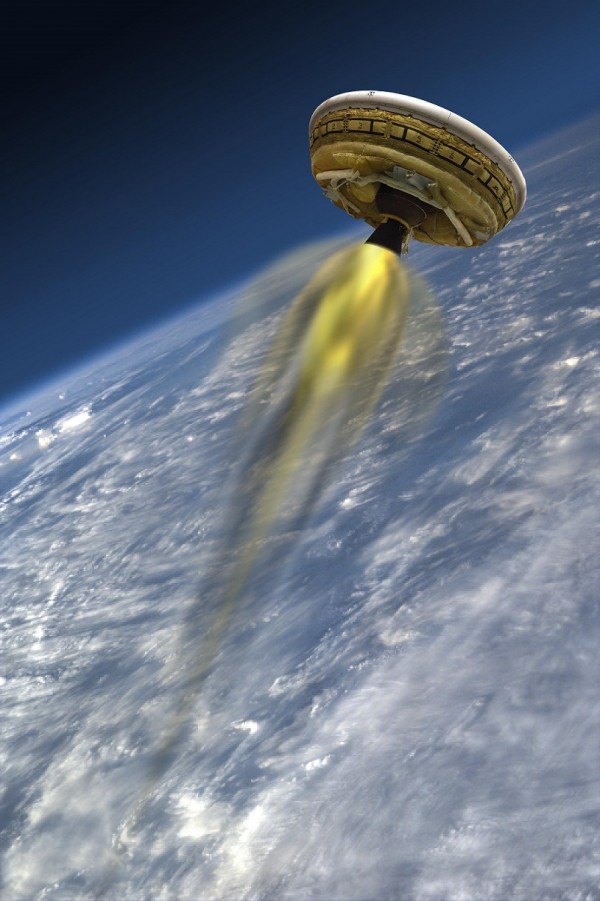It's Real: NASA Tests New 'Flying Saucer' for Mars
| Ana Verayo | | Apr 01, 2015 04:15 AM EDT |
(Photo : NASA/JPL-Caltech) This artist's concept shows the Low-Density Supersonic Decelerator (LDSD) designed to test landing technologies for future Mars missions.
NASA has just conducted the first ever spin test of its newest "flying saucer" slated for future Mars missions in 2030.
This aerodynamic test vehicle is called the Low-Density Supersonic Decelerator (LDSD) and is designed to help NASA scientists and engineers carry scientific payload and even astronauts to Mars in the future. The flying saucer-shaped vehicle measures 15 feet across and weighs 7,000 pounds.
Like Us on Facebook
The spin test was conducted at NASA's lab in La Cañada, Flintridge. During the test, journalists and the public were asked to shield themselves behind bulletproof glass. This specific test was designed to makes sure the spin mechanism of the spacecraft was balanced but the saucer never spun faster than 30 revolutions per minute.
According to Paul Lytal, a NASA engineer working on the project, NASA's trying to make the center of the mass of the craft as close to the spin motor as possible.
In a few weeks, the saucer will be transported to Hawaii. It will be attached to a balloon that will float some 160,000 feet into the atmosphere. Once at this altitude, a rocket will boost it further to 20,000 feet into the thinning stratosphere.
The logic behind this is to simulate the atmosphere on Mars, which is one percent as dense as Earth's. The stratosphere provides the perfect testing environment for the LDSD. Engineers are hoping to understand these new decelarating technologies.
Last June 2014, NASA successfully tested the LDSD using rocket power from the Navy's Pacific Missile Range Facility in Hawaii. Another test will be carried out in a few months.
Mars has a stratosphere than can help vehicles deploy but it can also become unpredictable, according to Kevin Burke, flight systems manager for the LDSD project. This same technology has been used by NASA starting with NASA's Viking probe in 1976 where a parachute design helped the landers and rovers touch down on the Martian surface intact.
NASA will need to test new parachute technology since it plans to land bigger spacecraft on Mars and eventually astronauts so a landing system is pivotal.
Last year, the LDSD had a test flight to try out new, decelerating technologies. The first one was a gigantic parachute measuring 100 feet in diameter and the other was an inflatable inner tube that can increase the size of the LDSD from 15 to 20 feet in a fraction of second to create more drag when it lands.
This inner tube, also known as the Supersonic Inflatable Aerodynamic Decelerator, was a success. The gigantic parachute was shredded to pieces instantly, however.
Since then, NASA's LDSD team completely redesigned the parachute. Researchers are hopeful that this time around, it will perform better than the original one a few months from now.
TagsIt's Real: NASA Tests New 'Flying Saucer' for Mars, NASA, NASA LDSD, NASA flying saucer, NASA flying saucer spin tests, NASA flying saucer mars, Mars
©2015 Chinatopix All rights reserved. Do not reproduce without permission
EDITOR'S PICKS
-

Did the Trump administration just announce plans for a trade war with ‘hostile’ China and Russia?
-

US Senate passes Taiwan travel bill slammed by China
-

As Yan Sihong’s family grieves, here are other Chinese students who went missing abroad. Some have never been found
-

Beijing blasts Western critics who ‘smear China’ with the term sharp power
-

China Envoy Seeks to Defuse Tensions With U.S. as a Trade War Brews
-

Singapore's Deputy PM Provides Bitcoin Vote of Confidence Amid China's Blanket Bans
-

China warns investors over risks in overseas virtual currency trading
-

Chinese government most trustworthy: survey
-

Kashima Antlers On Course For Back-To-Back Titles
MOST POPULAR
LATEST NEWS
Zhou Yongkang: China's Former Security Chief Sentenced to Life in Prison

China's former Chief of the Ministry of Public Security, Zhou Yongkang, has been given a life sentence after he was found guilty of abusing his office, bribery and deliberately ... Full Article
TRENDING STORY

China Pork Prices Expected to Stabilize As The Supplies Recover

Elephone P9000 Smartphone is now on Sale on Amazon India

There's a Big Chance Cliffhangers Won't Still Be Resolved When Grey's Anatomy Season 13 Returns

Supreme Court Ruled on Samsung vs Apple Dispute for Patent Infringement

Microsoft Surface Pro 5 Rumors and Release Date: What is the Latest?










